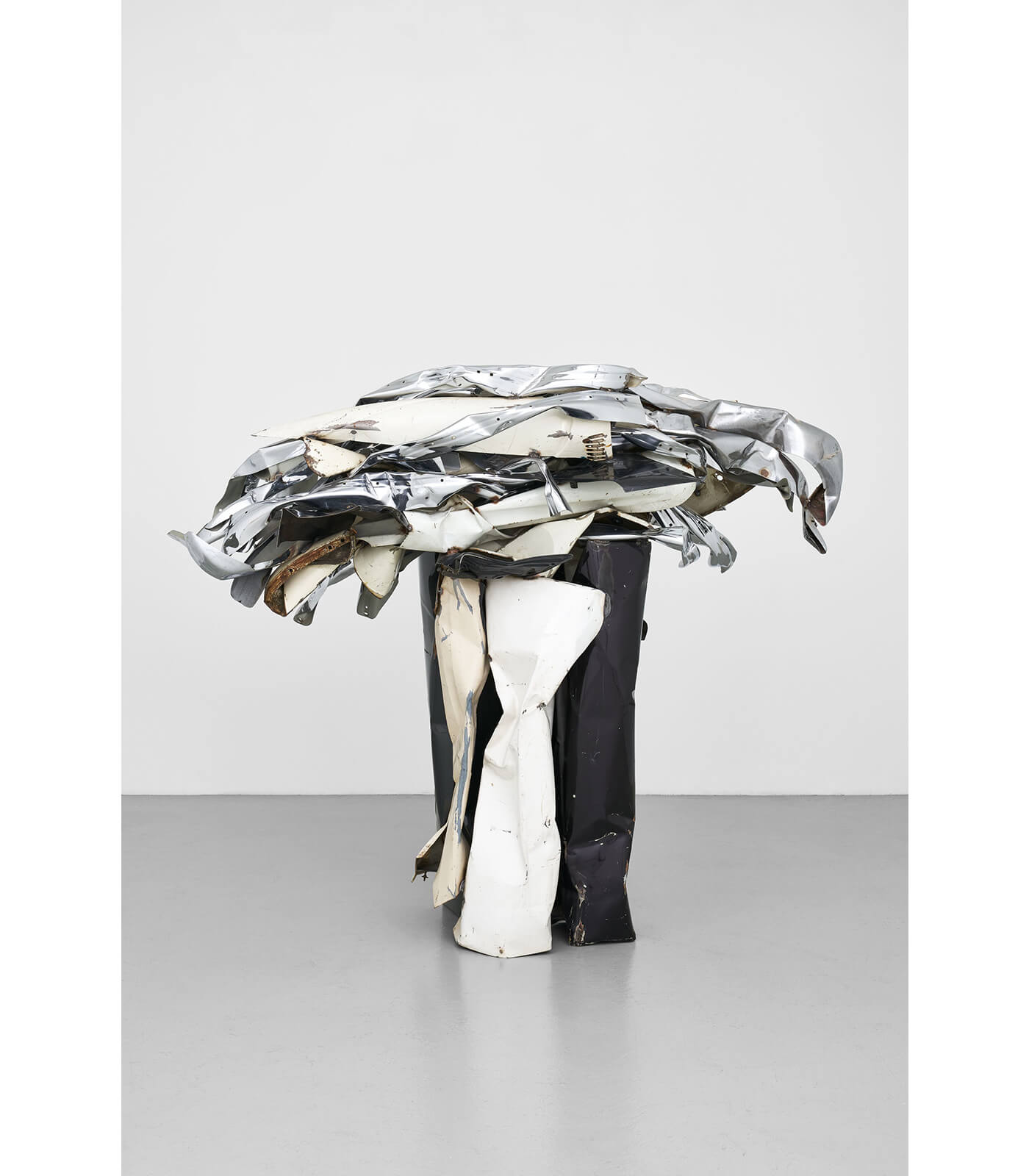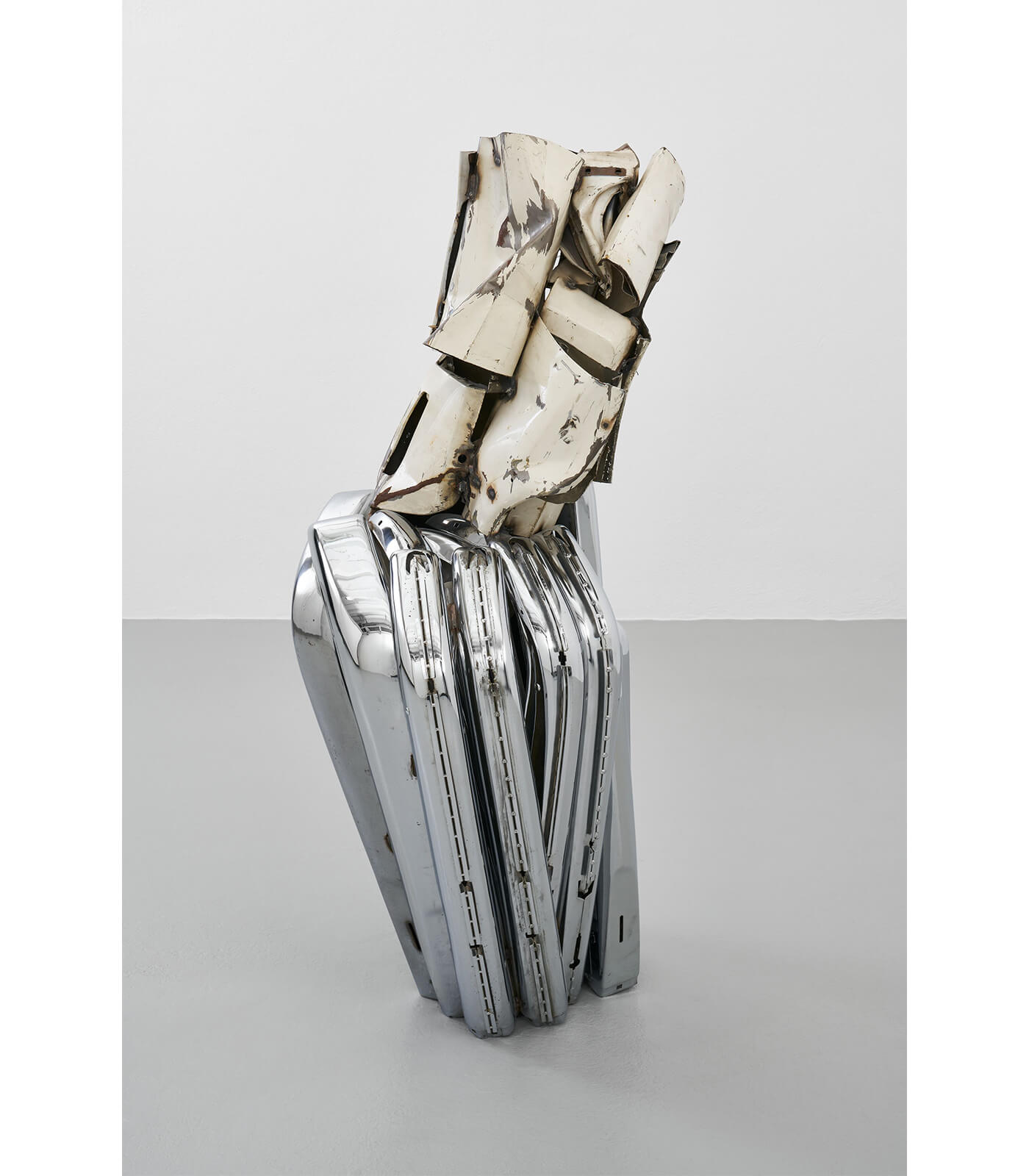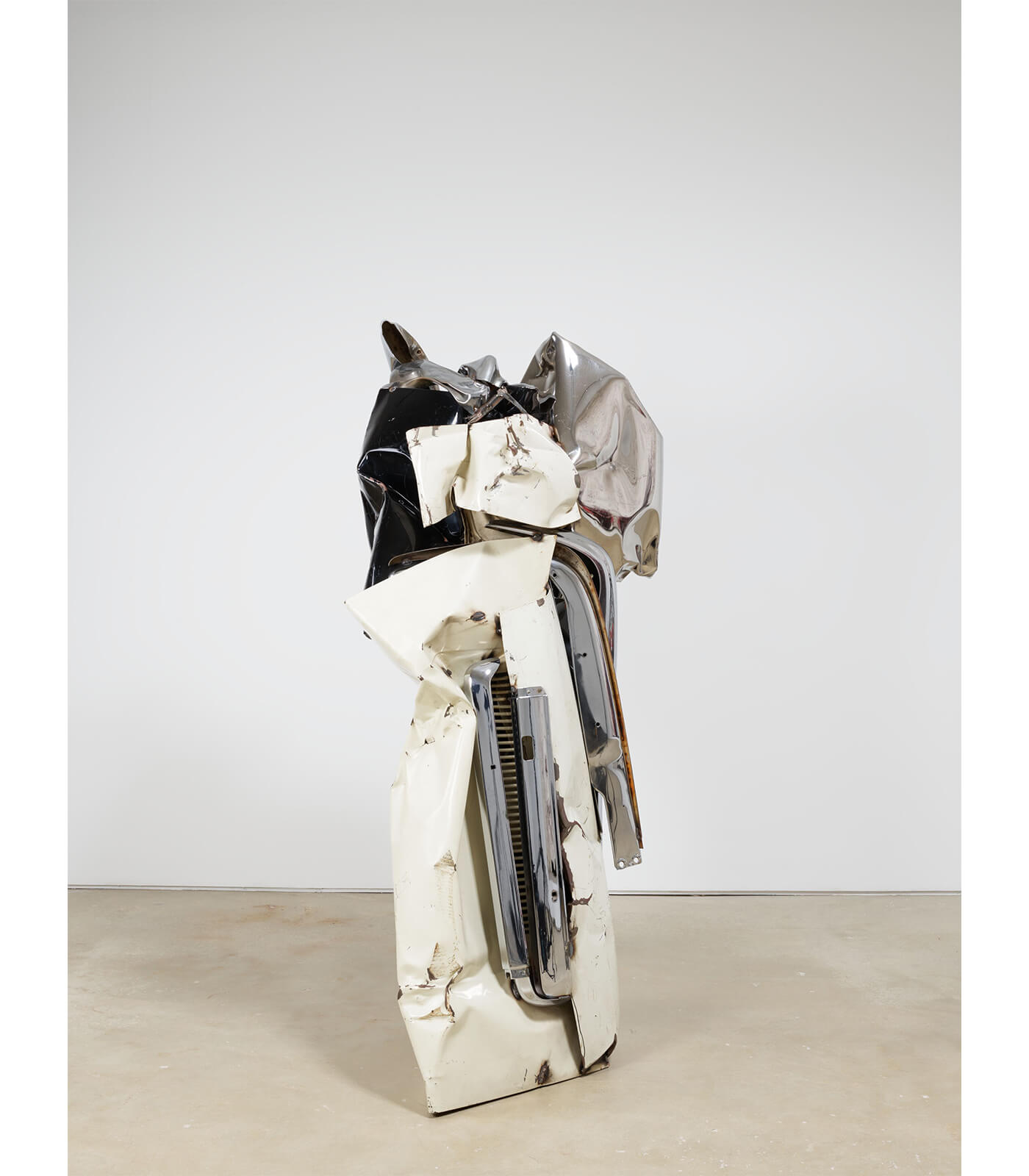
John Chamberlain
Reclaimed
1 April – 21 May 2022
Zurich, Bahnhofstrasse 1
John Chamberlain was a quintessentially American artist, channelling the innovative power of the post-war years into a relentlessly inventive practice spanning six decades.
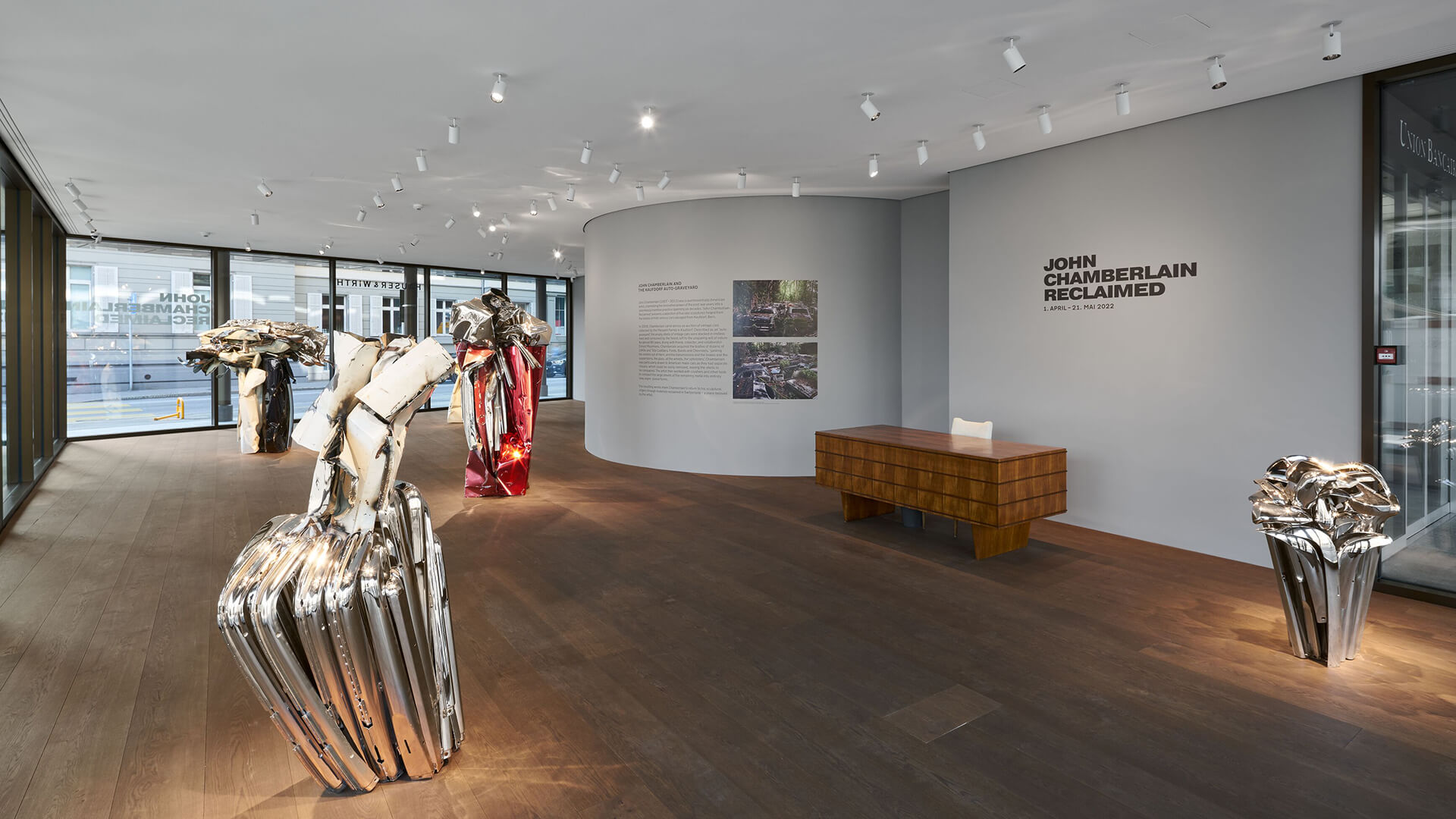
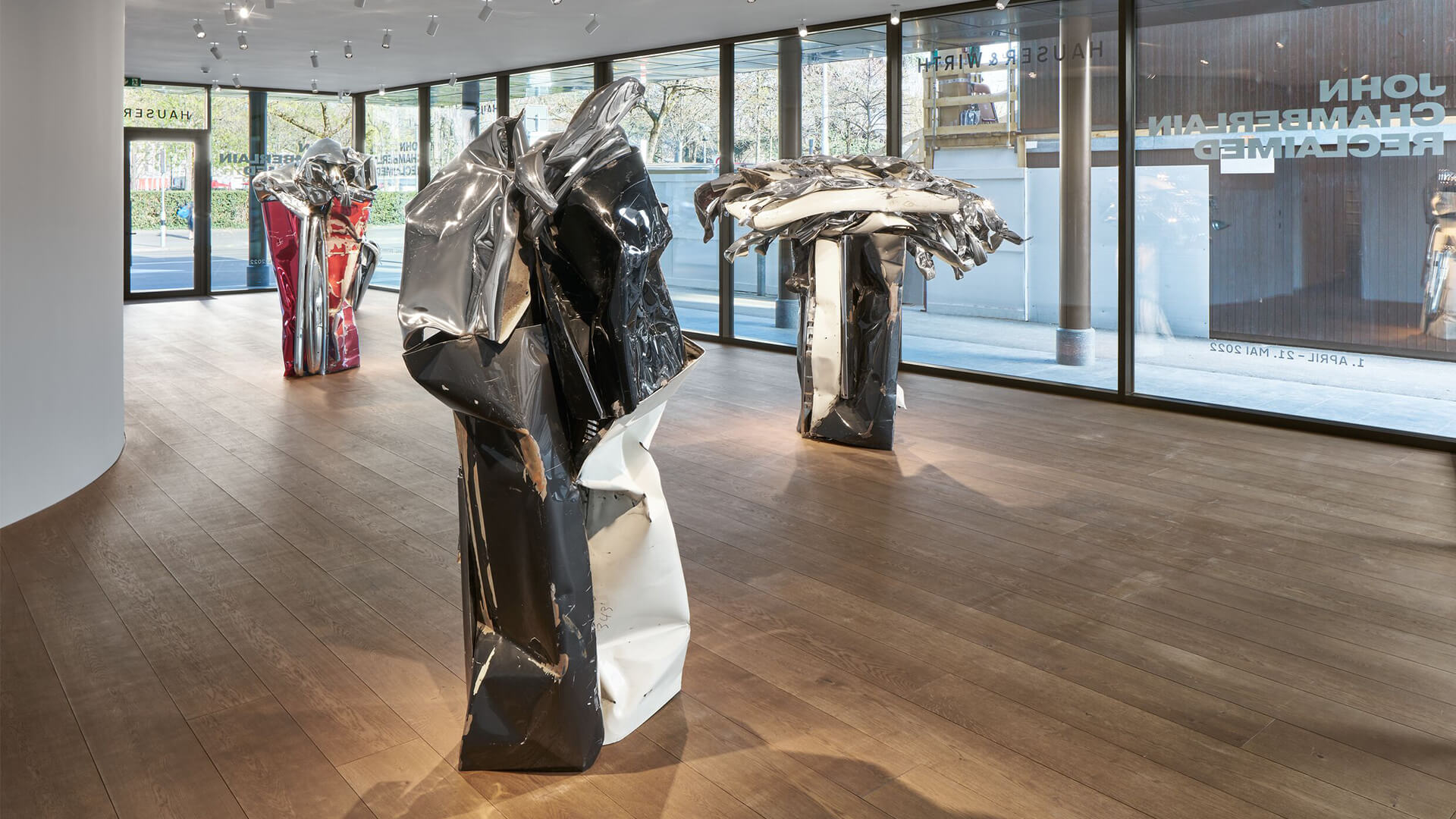
Explore the exhibition
Now on view at Bahnhofstrasse 1, we host our first exhibition of the artist’s work in Switzerland. ‘John Chamberlain. Reclaimed’ will present a selection of five late sculptures forged from the bodies of mid-century cars that were salvaged from Kaudorf, Bern. These vintage Cadillacs, Fords, Buicks and Chevrolets bear the chromatic imprint of the era. In primarily black, white, and silver, Chamberlain returns to his sculptural origins through employing the repurposed materials of a historic and treasured destination.
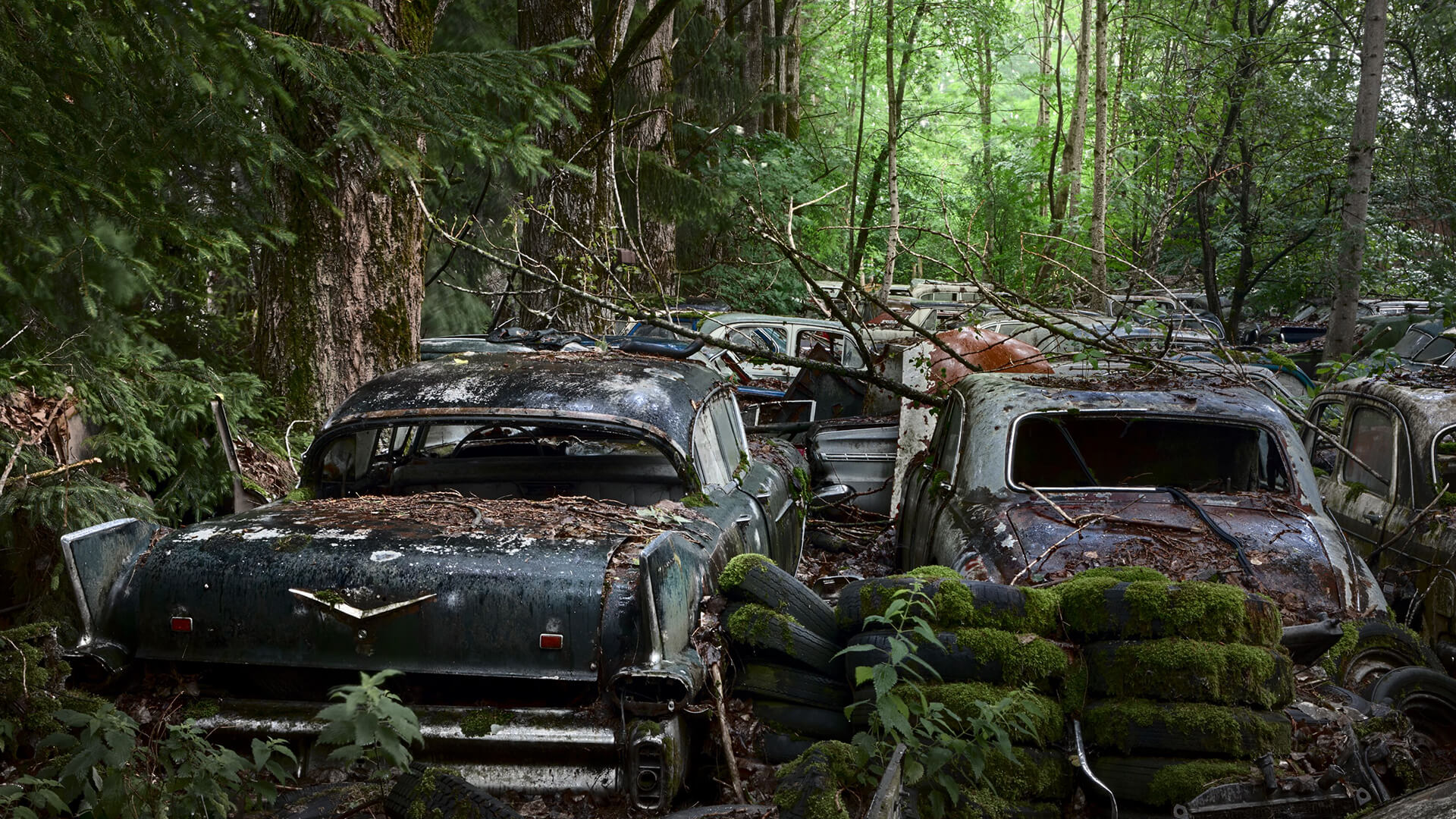
In 2009, Chamberlain came across an auction of vintage cars collected by the Messerli family in Kaufdorf, Bern. Described as an ‘auto graveyard’, the empty shells of vintage cars were stacked in endless rows and consumed by the forest, left to the unsparing will of nature for almost 80 years. Along with friend, collector, and collaborator Ernest Mourmans, Chamberlain acquired the bodies of dozens of 1940s and ’50s automobiles, ‘yanking motors out of them, and the transmissions and the brakes and the suspensions, the glass, all the wheels, the upholstery’. Chamberlain was particularly drawn to American-made cars as they had separate chassis, which could be easily removed, leaving the shells to be conquered. The artist then worked with crushers and other tools to compact the large sheets of the remaining metal into entirely new, expressionist forms.
Vintage cars in the Franz Messerli auto-graveyard in Kaufdorf, Bern, 2009 © Erik and Petra Hesmerg and More Gallery. Courtesy Fairweather & Fairweather LTD and More Gallery
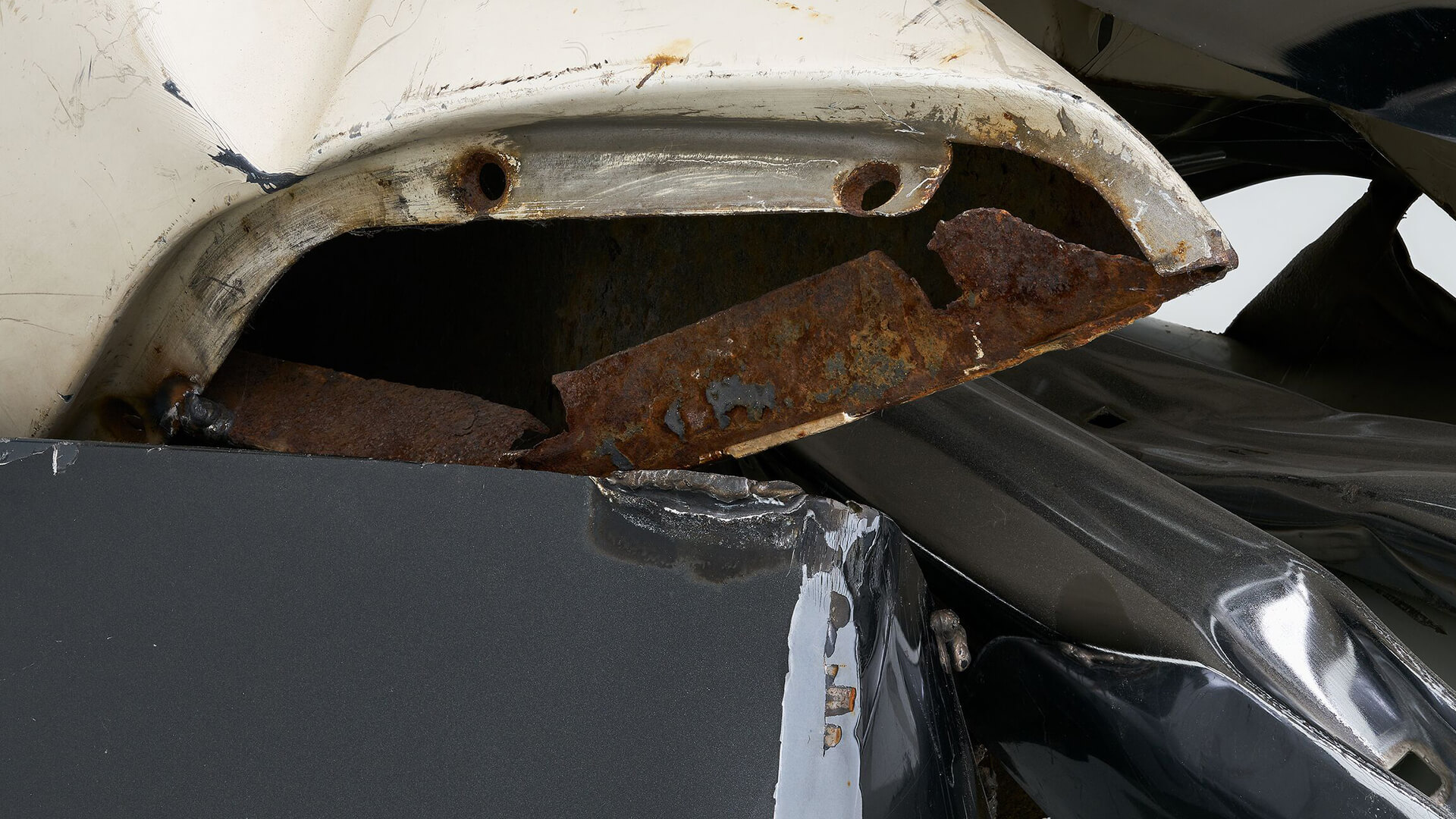
Chamberlain first gained renown for his sculptures constructed from automobile scrap metal in the late 1950s and 1960s. These were ground-breaking works that effectively transformed the gestural energy of abstract expressionist painting into three dimensions. Beginning in the 1970s, he began to experiment with an array of other found materials such as foam rubber, Plexiglas, paper bags and aluminium foil.
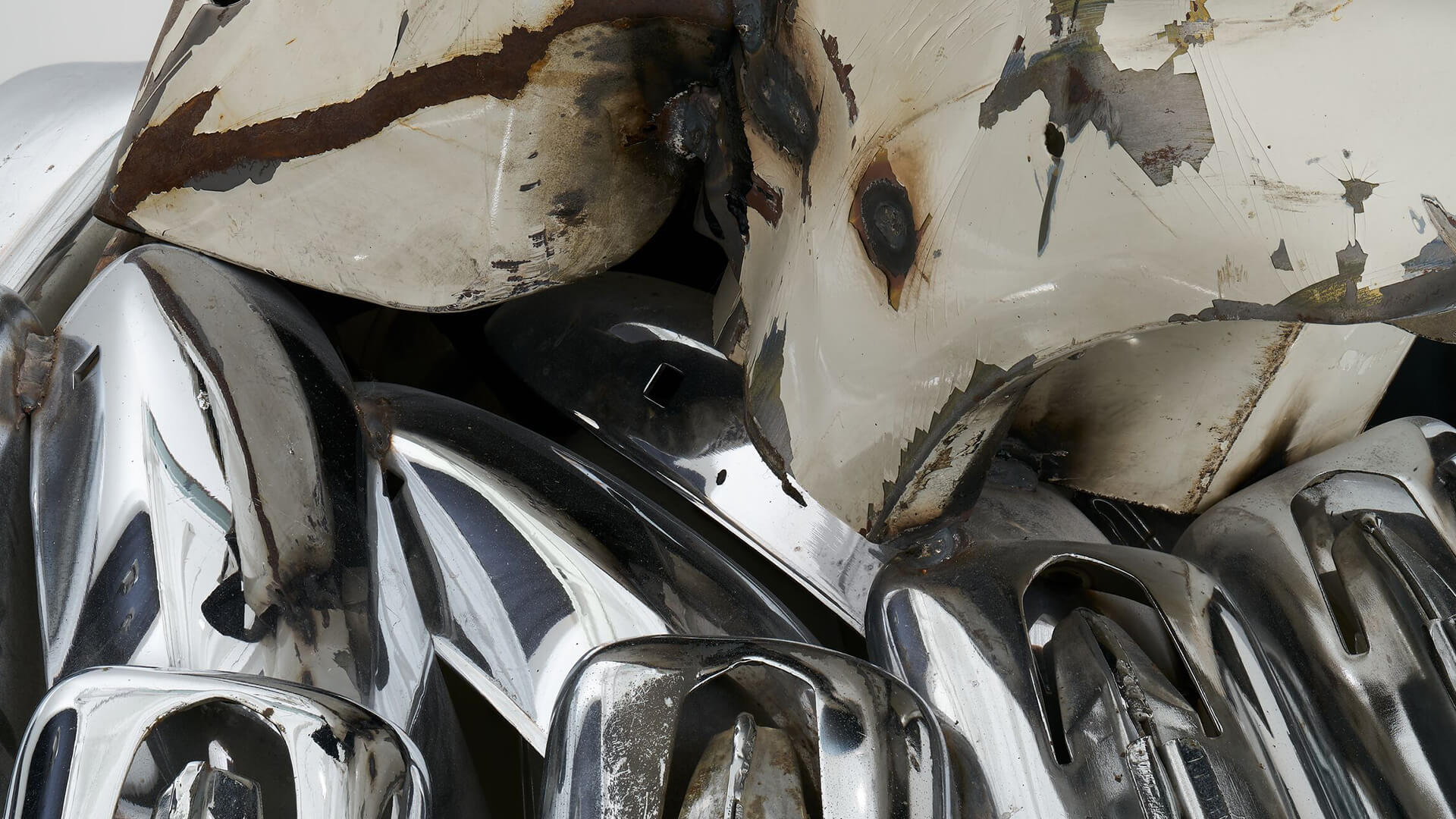
These playful explorations often informed his work with automotive scrap metal—his ideal ‘art supply’—which continued throughout his career. The late works on view in Zurich explore the formal and full expressive potential of this once abandoned industrial material. While some series of works employed metals which were augmented with colour and pattern by Chamberlain, this series derives its palette entirely from the original paint finish applied to the metals from these mid-century cars.
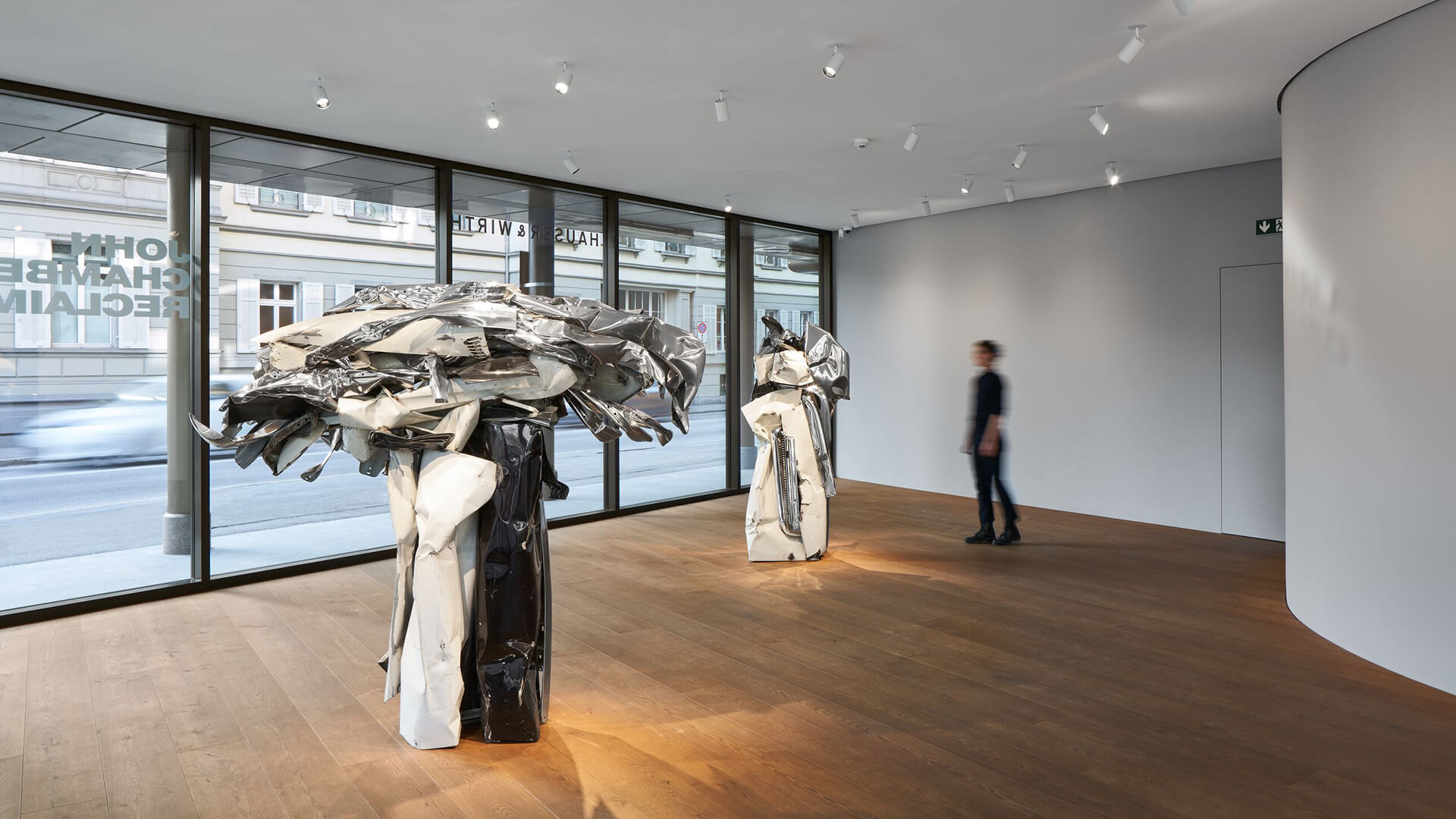
Welding bumpers and fenders around and within the crushed structures of metal, Chamberlain boldly challenges all notions of balance, color, form, and volume. Works such as ‘BISHOPBUDD’ (2009) defy gravity as a crown of black, white and chrome strips sits atop a dense trunk of painted steel. ‘EMPIREMICROPHONE’ (2009) features the curvilinear forms of bumpers in bold contrast to the crumpled, timeworn steel balanced above. By employing a limited color palette of black and white punctuated with reflective chrome, Chamberlain renders the density of steel into something that is seemingly weightless and fluid, elegant and powerful.
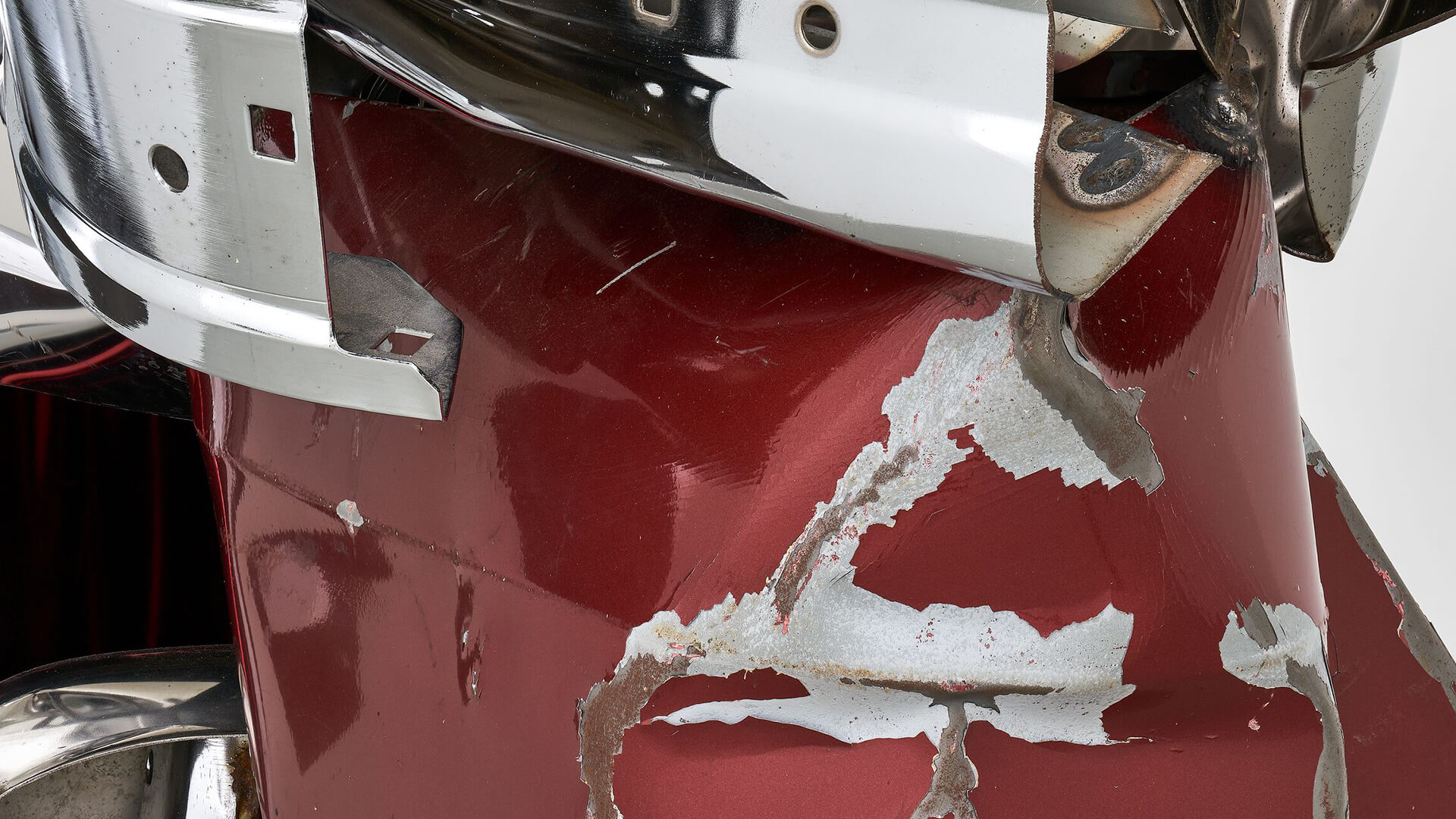
Standing within the monochromatic forest of sculptures, ‘ENTIRELYFEARLESS’ (2009) preserves the original red paintwork of the automobile from which it was welded. Demonstrating the artist’s skilled ability to balance color and texture, this work echoes his belief that sculpture denotes a great deal of physicality, disrupting whatever space it occupies. Chamberlain worked in the round; from every perspective, the sculptures on view propose a new composition as the viewer explores each eccentric fold, twist and curl of steel. The mindful placement of the crushed car parts result in impossibly dynamic works that transform their original functionality into new and intriguing forms while establishing a pop art vernacular through the artist’s use of the ready-made.

ENTIRELYFEARLESS
2009
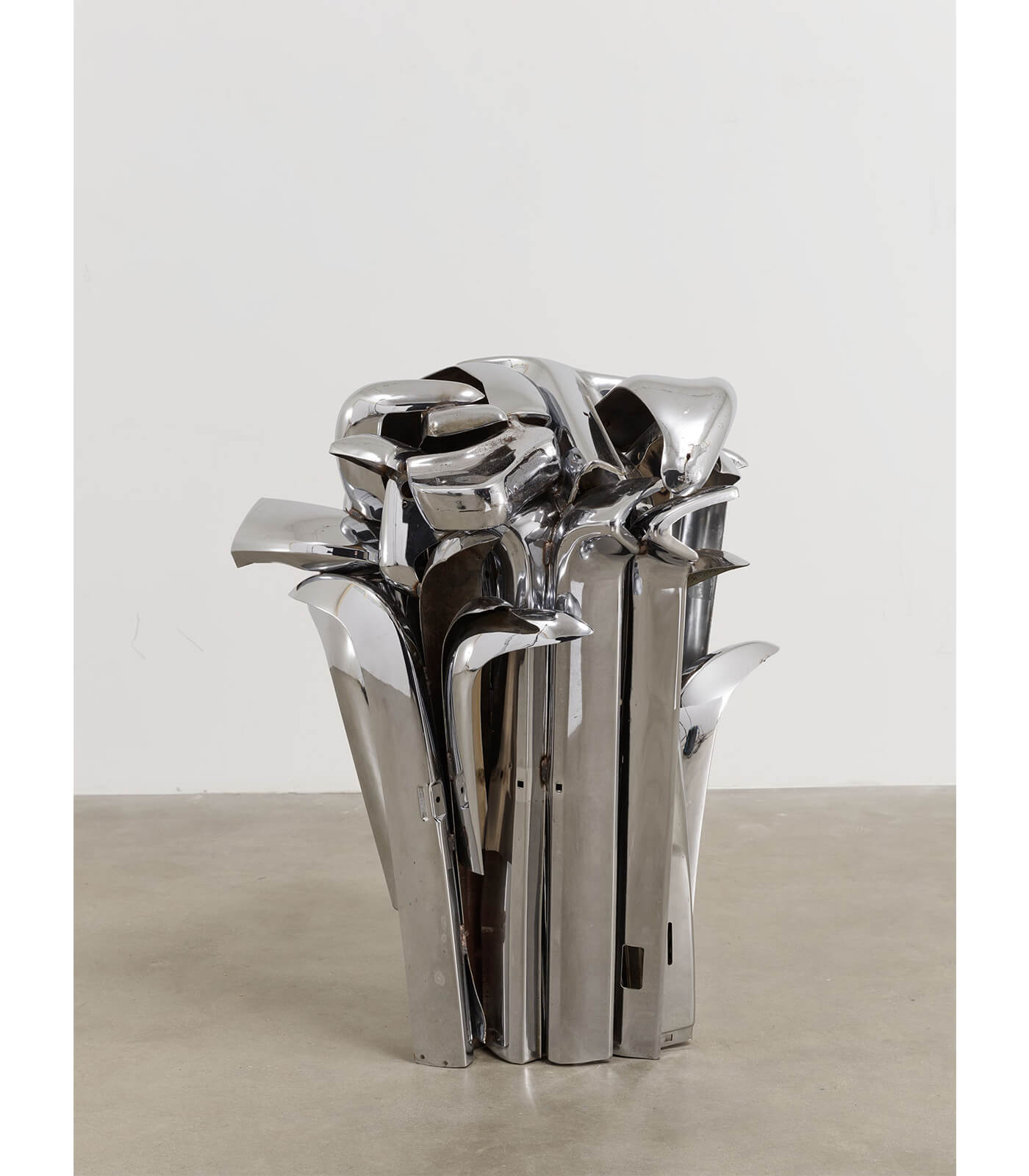
KICKBACKPONGEE
2009
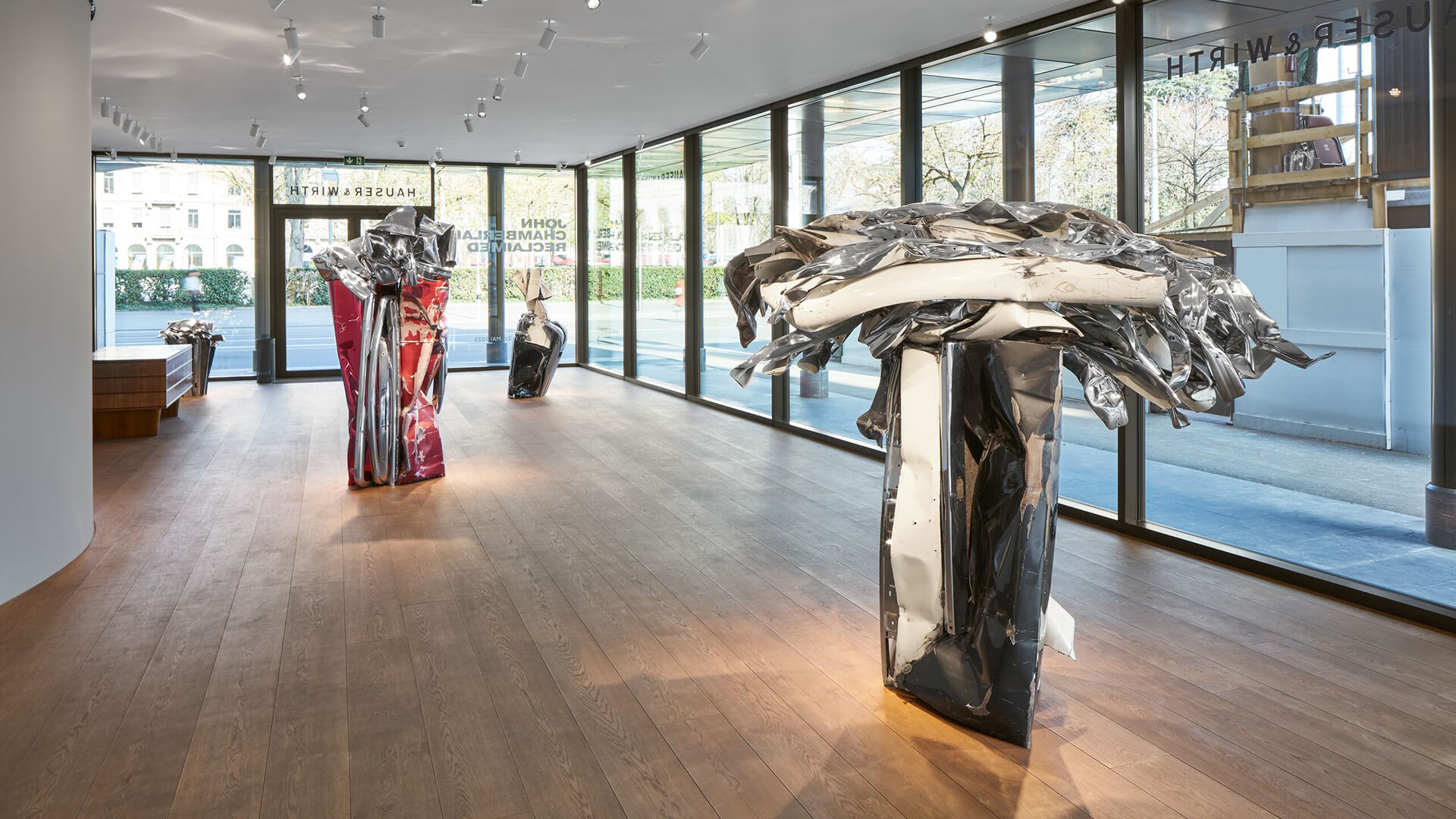
Chamberlain’s daughter Alexandra Fairweather once shared a memory of their time in Switzerland: ‘Chamberlain and I were having coffee in Zurich and as a journalist was interviewing him, he mentioned how he was the first ‘recyclist.’ And after thinking about all of those automobiles, left to deteriorate in those fields… I realized he absolutely was in many respects a ‘recyclist.’’
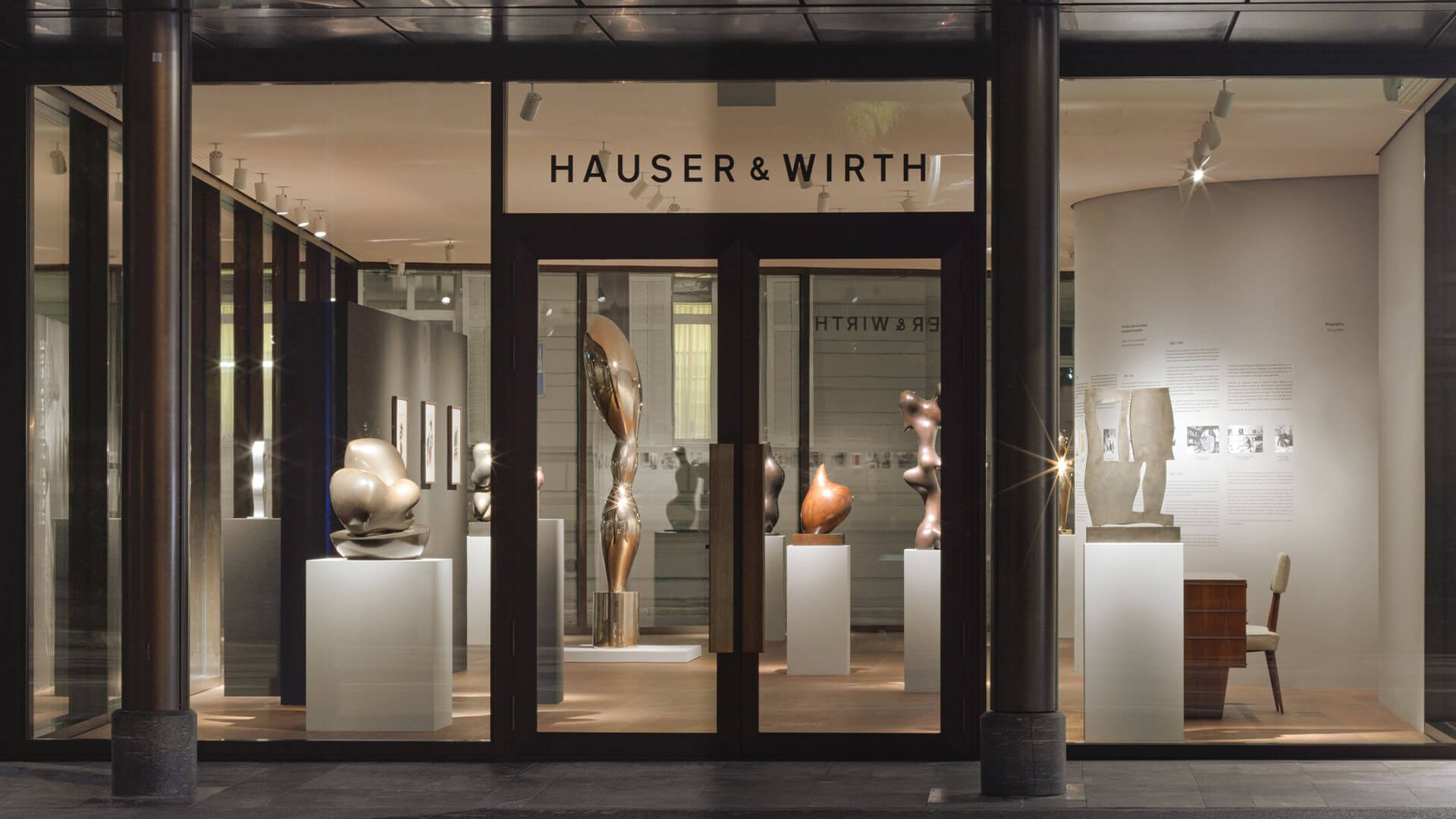
On view in Zurich, Bahnhofstrasse 1
The gallery is open Tue – Fri, 10 am – 6 pm, Sat, 11 am – 5 pm. Please visit our location page to plan your visit.
Photo: Vintage cars in the Franz Messerli auto-graveyard in Kaufdorf, Bern, 2009 © Erik and Petra Hesmerg and More Gallery. Courtesy Fairweather & Fairweather LTD and More Gallery
About the Artist
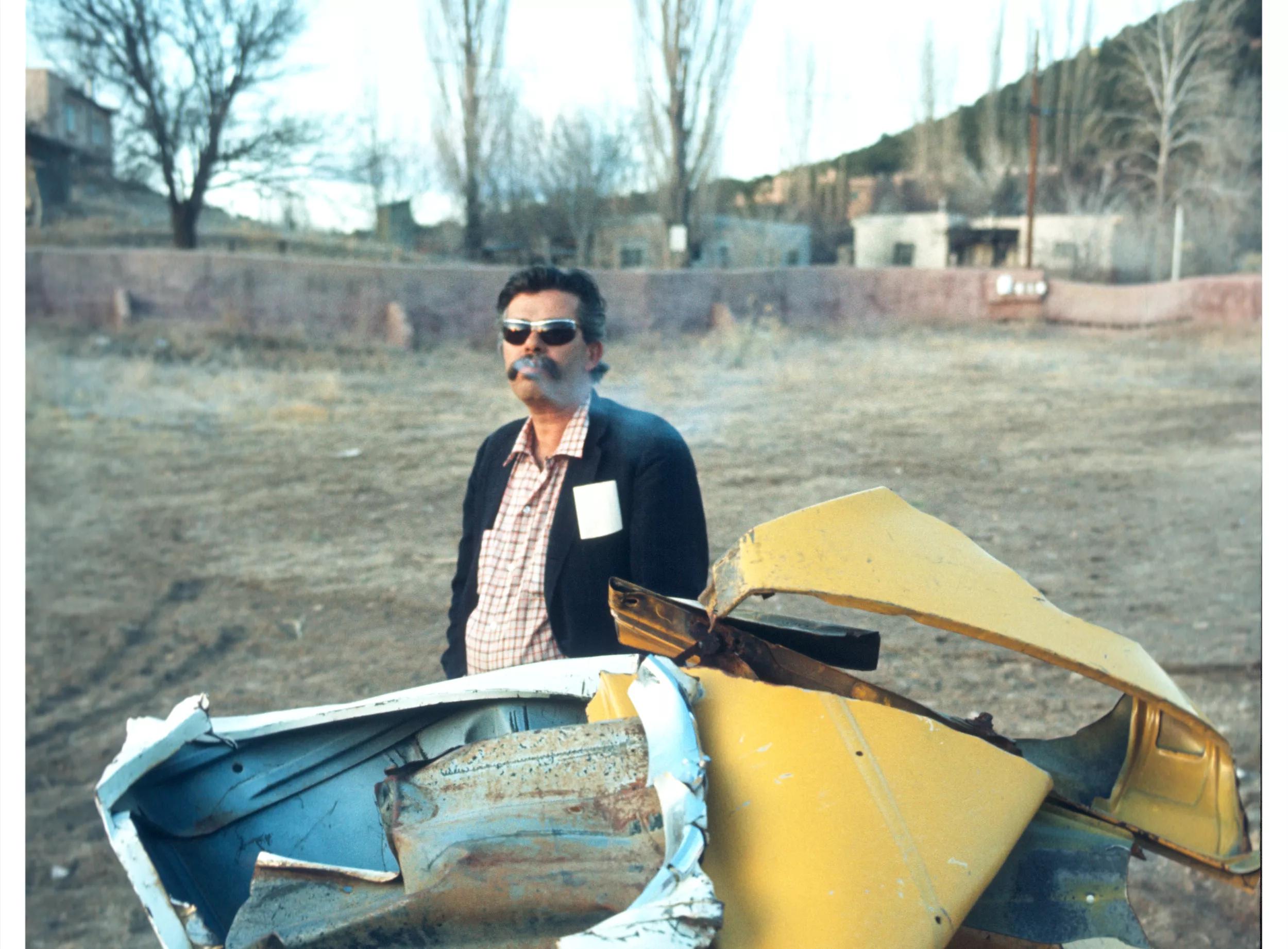
John Chamberlain
John Chamberlain (1927 – 2011) was a quintessentially American artist, channeling the innovative power of the postwar years into a relentlessly inventive practice spanning six decades. He first achieved renown for sculptures made in the late 1950s through 1960s from automobile parts—these were path-breaking works that effectively transformed the gestural energy of Abstract Expressionist painting into three dimensions. Ranging in scale from miniature to monumental, Chamberlain’s compositions of twisted, crushed, and forged metal also bridged the divide between Process Art and Minimalism, drawing tenets of both into a new kinship. These singular works established him as one of the first American artists to determine color as a natural component of abstract sculpture. From the late 1960s until the end of his life, Chamberlain harnessed the expressive potential of an astonishing array of materials, which varied from Plexiglas, resin, and paint, to foam, aluminum foil, and paper bags.
After spending three years in the United States Navy during World War II, Chamberlain enrolled in the Art Institute of Chicago and Black Mountain College, where he developed the critical underpinnings of his work. Chamberlain lived and worked in many parts of the United States, moving between New York City, Long Island, Los Angeles, Santa Fe, Connecticut, and Sarasota, before finally settling on Shelter Island. In many ways, each location provoked a distinct material sensibility, often defined by the availability of that material or the limitations of physical space. In New York City, Chamberlain pulled scrap metal and twelve-inch acoustic tiles from the ceiling of his studio apartment. He chose urethane in Los Angeles in 1965 (a material he had been considering for many years), and film in Mexico in 1968. He eventually returned to metal in 1972, and, in Sarasota, he expanded the scale of his works to make his iconic Gondolas (1981 – 1982). The movement of the artist and the subsequent evolution of the work is indicative not only of a kind of American restlessness but also of Chamberlain’s own personal evolution: he sometimes described his use of automobile materials as sculptural self-portraits, infused with balance and rhythm characteristic of the artist himself.
Chamberlain refused to separate color from his practice, saying, ‘I never thought of sculpture without color. Do you see anything around that has no color? Do you live in a world with no color?’. He both honored and assigned value to color in his practice—in his early sculptures color was not added, but composed from the preexisting palette of his chosen automobile parts. Chamberlain later began adding color to metal in 1974, dripping and spraying—and sometimes sandblasting—paint and lacquer onto his metal components prior to their integration. With his polyurethane foam works, color was a variable of light: ultraviolet rays or sunlight turned the material from white to amber. It was this profound visual effect that brought the artist’s personal Abstract Expressionist hand into industrial three-dimensional sculpture. Chamberlain moved seamlessly through scale and volume, creating material explorations in monumental, heavy-gauge painted aluminum foil in the 1970s, and later in the 1980s and 1990s, miniatures in colorful aluminum foil and chromium painted steel.
Central to Chamberlain’s works is the notion that sculpture denotes a great deal of weight and physicality, disrupting whatever space it occupies. In the Barges series (1971 – 1983) he made immense foam couches, inviting spectators to lounge upon the cushioned landscape. At the end of his career, Chamberlain shifted his practice outdoors, and through a series of determined experiments, finally created brilliant, candy-colored sculptures in twisted aluminum foil. In 2012, four of these sculptures were shown outside the Seagram Building in New York, accompanied by playful titles such as ‘PINEAPPLESURPRISE’ (2010) and ‘MERMAIDSMISCHIEF’ (2009). These final works exemplify Chamberlain’s lifelong dedication to change—of his materials, of his practice, and, consequently, of American Art.
Chamberlain has been the subject of numerous solo exhibitions, including two major Retrospectives at the Solomon R. Guggenheim Museum in New York NY in 2012 and 1971; ‘John Chamberlain, Squeezed and Tied. Foam and Paper Sculptures 1969-70,’ Dan Flavin Art Institute, Dia Center for the Arts, Bridgehampton NY (2007); ‘John Chamberlain. Foam Sculptures 1966–1981, Photographs 1989–2004,’ Chinati Foundation, Marfa TX (2005); ‘John Chamberlain. Current Work and Fond Memories, Sculptures and Photographs 1967–1995,’ Stedelijk Museum, Amsterdam, Netherlands (Traveling Exhibition) (1996); and ‘John Chamberlain. Sculpture, 1954–1985,’ Museum of Contemporary Art, Los Angeles CA (1986). Chamberlain’s sculptures are part of permanent exhibitions at the Chinati Foundation in Marfa TX and at Dia:Beacon in upstate New York. In 1964, Chamberlain represented the United States in the American Pavilion at the 32nd International Exhibition of the Venice Biennale. He received many awards during his life, including a Doctor of Fine Arts, honoris causa, from the College for Creative Studies, Detroit (2010); the Distinction in Sculpture Honor from the Sculpture Center, New York (1999); the Gold Medal from The National Arts Club Award, New York (1997); the Lifetime Achievement Award in Contemporary Sculpture by the International Sculpture Center, Washington D.C. (1993); and the Skowhegan Medal for Sculpture, New York NY (1993).
Inquire about available works by John Chamberlain.
‘John Chamberlain. Reclaimed’ is on view now through 21 May 2022 at Hauser & Wirth Bahnhofstrasse 1.
Current Exhibitions
1 / 10
